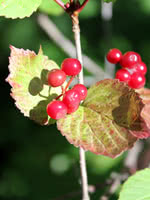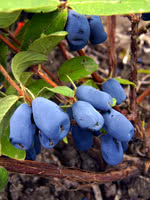Mon-Fri 9am - 5pm Mountain time
Tundra Haskap (Honeyberry) vs Lowbush Cranberry
Viburnum edule
Lonicera caerulea Tundra
NOT AVAILABLE THIS SEASON - MIGHT RETURN
Lowbush Cranberry is a short, deciduous shrub native to North America. Its white flowers bear sour but edible fruit that ripens to a brilliant red in fall. Lowbush Cranberry's small size makes it suitable for urban use; buyers will also find it useful if trying to reclaim land back to its original species or when landscaping with native species in damp conditions.
Tundra Haskap is sweet/tangy with a great flavour. The flavour of Haskaps is generally described as a cross between a blueberry and a raspberry. Tundra Haskaps are well suited to fresh eating, freezing, baking, and preserves. They have the firmest berries, which makes them well-suited for commercial production
For optimal fruit production, cross-pollination is required. Haskaps need to be planted with a compatible variety. Compatibility is influenced by both bloom time and genetics.
Tundra Haskap is an early-pollinating variety and pairs well with Aurora and Honey Bee.

